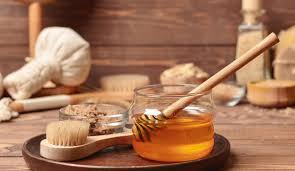
Honey in Skin Care
Honey, commonly found alongside a cup of tea, is made by bees and has multiple functions in skin care stemming from its antimicrobial, antioxidant, and anti-inflammatory activity.
Because of these properties, honey is great to use in treatments of acne, eczema, and other inflammation or bacterial concerns.
Though it makes your skin photosensitive, honey contains free radical binding antioxidants that help prevent genetic damage from UV radiation. For that reason, honey can be used to treat sun damage, but not to prevent it.
To find out if this ingredient is a good addition to your custom skin care regimen, read below and take our quiz to find your Baumann skin type and get a dermatologist recommended skin care routine. If you’re just looking for my recommendations on the best products with honey, here are some great choices:
Take the Quiz
Table of contents
Honey in Skin Care
What is honey made of?
Different compositions of bee products
What is Propolis?
What is Royal Jelly?
Benefits
Side-effects
Is it safe?
Acne
Dry skin
Sun damage
Wrinkles and aging
Masks
Products
References
What is honey made of?
Honey is made almost entirely of sugars like glucose and fructose (80-85%).
About 10-15% of honey is water.
It is acidic.
Besides sugars and water, it also contains small amounts of various proteins, amino acids, fatty acids, vitamins, and phenolic compounds with a range of properties. (7-11)
Based on which plant the bees use, the active compounds can vary significantly between honey varieties. (7,12)
Other than just the flowers involved, weather, climate, storage, and many other factors exist that can change the chemical composition of honey.
Glycerin (glycerol) is present in this ingredient, a major contributor to its humectant properties.
Some flowers whose nectar commonly ends up in honey can include:
Borage
Lavender
Manuka
Peppermint
Rose
What is honey made from
Different compositions of bee products
Since honey is made through the process of bees collecting nectar from various plants local to their environments, it can have a variety of chemical compositions.
In one study comparing the composition of 18 kinds of honey, different phenolic breakdowns were present in each of the specimens reviewed (with many re-occurring compounds.) (1)
The flower type used by bees to produce a particular batch of honey determines the type of chemical compounds in the resulting honey. Some compounds in honey are fairly unique to certain plants, like Linalool from lavender plants.
What is Propolis?
Propolis has been used in skin care for hundreds of years for the purposes of wound care. (4)
The word propolis is of Greek origin, it means pro-(before) -polis(city) which might reflect on the thought that bees constructed buildings and communities before humans did.
Propolis is one of the three primary products of bee agriculture next to honey and beeswax and is a thick, adhesive substance that bees make from tree sap; it is used to seal and attach the various compartments of bee hives.
This substance is much thicker and stickier than honey is, and expresses many of the same benefits such as anti-inflammatory and antimicrobial benefits.
Some studies have found that propolis might be an effective preventative and reactive treatment to certain kinds of tumors. (5) But more research on cancer treatments is necessary.
Propolis has a lower sugar content than honey, so it is less likely to cause glycation than honey is.
Hundreds of active compounds from phenols to flavonoids have been discovered in multiple specimens of propolis that vary based on the origin of the propolis. Different bees with different plants produce propolis with different compounds.
Some commonly occurring compounds in studied specimens of propolis were: (6)
Bisabolol
Caffeic acid
Ferulic acid
If you are interested in using honey products but are prone to skin aging, propolis might be a better option for your custom skin care regimen.
Keep your eyes open for our blog all about propolis, coming soon!
What is Royal Jelly?
Royal jelly is also produced by bees, but it is significantly different from honey in both composition and production. (14)
Royal jelly is a secretion from the jaws (mandibles) of bees that is rich in nutrients. It is only for the queen bee.
Unlike honey which can cause glycation on the skin, potentially leading to skin aging, royal jelly has a low sugar content that does not cause significant glycation.
In addition, royal jelly is known to stimulate collagen production in the skin, which means it might actually be a good choice for anti-aging regimens depending on your skin type.(15,16)
Interestingly, royal jelly expresses photoprotective activity that typical bee honey does not express. For this reason, royal jelly might be beneficial as an additive in various sunscreens or high SPF products.
Royal jelly has anti-inflammatory, antioxidant, and humectant properties.
Overall, royal jelly is a useful ingredient in skin care because is offers all (if not more) of the same benefits with a lower risk of collagen/elastin glycation. However, it is a very expensive ingredient.
A blog dedicated to royal jelly in skin care is on the way!
Honey in skin care
Benefits
Honey has been used for medical and cosmetic purposes for hundreds of years because it has notable antimicrobial, anti-inflammatory, and antioxidant effects. (2)
When honey is used on the skin, it starts to release hydrogen peroxide, a potent antimicrobial compounds that eliminates bacteria and lowers skin pH. (6)
It is soluble in water and works as a humectant, meaning honey can be good in certain products designed for hydrating the skin.
Because of the various positive properties of honey, it can be found in treatments for acne, burns, eczema, cracked lips, sun damage, and more.
Low pH ingredients like honey are common in cleansers for regulating the pH environment of the skin.
Based on the botanical components present, honey can express benefits from the flowers they were made from.
Side-effects
Carbohydrates such as the sugars that make up honey are known to cause glycation on the skin. (13)
Glycation on the skin is not dissimilar from the way sugar becomes caramel in a cooking pot. It is the Maillard reaction happening on skin.
When sugar molecules are exposed to proteins in the skin, a chain reaction begins that harms the structures of those proteins, which can lead to skin aging concerns.
Glycation has an effect on collagen and elastin, both of which are crucial compounds for helping the skin maintain youth.
When elastin and collagen suffer glycation, the skin becomes more brittle, thin, and sensitive to photodamage.
For those reasons, it is important to avoid using honey in your skin care routine if you have wrinkle-prone or mature skin.
All that said, there has been some research that suggests the antioxidant properties and certain fatty acids present in this ingredient might offer protective anti-aging benefits, (3) so more research is definitely needed to be sure on honey’s effect on aging.
Is it safe?
Honey poses no significant health risks as a skin care ingredients unless you suffer from a specific allergy to it.
If you are allergic to a flower, you might want to avoid honey of that same flower as some of the plant’s original phenols are present in the final product.
it is a clean, non-toxic ingredient.
Overall, it is safe in skin care and does not pose a significant risk of allergy or causing acne, but it is not the best choice for anti-aging regimens.
To find out if honey is a good choice for your skin care, make sure to shop by your skin type which you can find by taking our quiz!
Take the Quiz
Honey for acne
Acne
Honey is a potent natural antibiotic, easily capable of eliminating acne-causing and other bacteria on the skin. (1,2,6)
In addition to killing bacteria, it is also an anti-inflammatory that reduces redness associated with clogged pores and acne.
Because honey is acidic, it changes the pH environment of the skin making it more difficult for bacteria to grow and thrive on the skin.
When applied to the skin, honey begins releasing hydrogen peroxide, an antimicrobial chemical known for its ability to treat acne.
For all these reasons, honey might be a good addition to your personal acne routine.
Dry skin
Honey is primarily composed of sugars which are soluble in water, this means they act as humectants which draws moisture together on the skin.
If you have dry skin, products containing this ingredient could help with quick alleviation of dry or inflamed skin.
Many dry skin concerns like eczema, itching, and flaking can all be treated by products containing honey.
There are many different kinds of moisturizers, so make sure to take our skin type quiz to find the best moisturizers for your specific skin type!
Sun damage
Ingredients that cause glycation on the skin have been shown in studies to increase photosensitivity because of harmful AGEs (Advanced Glycation End products) which result from sugars interacting with proteins and fats in the skin.(18)
Honey is known to increase photosensitivity on the skin when used in direct sunlight, so it can lead to sun damage in some cases. It does not prevent sun damage.
It can, however, treat pre-existing sun damage because it is rich in free radical scavenging antioxidants. Free radicals can damage the skin on a genetic level, so binding and eliminating those radicals is crucial for skin health.
What is glycation
Wrinkles and aging
As an ingredient composed primarily of sugars, use of honey on the skin can result in the glycation of collagen and elastin. This is bad for skin aging related concerns. (17)
Collagen and elastin are essential for giving the skin its springiness, resilience, and youthful appearance.
When sugars are exposed to skin proteins, a cascade effect begins that results in brittle collagen and elastin compounds.
On the contrary, some studies suggest that the arginine and glutamic acid content of honey stimulate collagen synthesis. (3)
In addition, this ingredient is known for its antioxidant capabilities, which is often a good sign for the efficacy of an anti-aging ingredient.
If not for the high sugar content of honey, it would be a far better candidate for anti-aging treatments than it is.
If you plan to use this ingredient in your skin care routine, using an anti-aging focused ingredient just after removing the honey is recommended to counteract the glycation caused by the sugars.
If you are wrinkle-prone, some common anti-aging ingredients to consider for your custom skin care regimen might be:
Peptides
Resveratrol
Retinoids
Ubiquinone
Vitamin C
Masks
A honey mask can be an effective part of a hygienic cleansing routine if you have acne prone skin.
As a potent antimicrobial and anti-inflammatory ingredient, honey masks can soothe redness associated with acne while also eliminating bacteria that would lead to further acne.
Low pH ingredients help normalize desquamation of the skin, or natural exfoliation.
For this reason, there are many masks and cleansers formulated with low pH which include acids like glycolic or salicylic acid.
Honey masks should be removed before applying other skin care products, or before going to bed or going outside.
Since honey is water soluble, a simple rinse will quickly make it less sticky. Rinse until no honey is left on your face.
Products
Many products on the market contain honey, propolis, and/or royal jelly. Here are my favorites!
Thanks for reading this blog all about honey in skin care! Be sure to find out your Baumann Skin Type using the quiz below so you can be sure the products you buy will really work for your skin.


